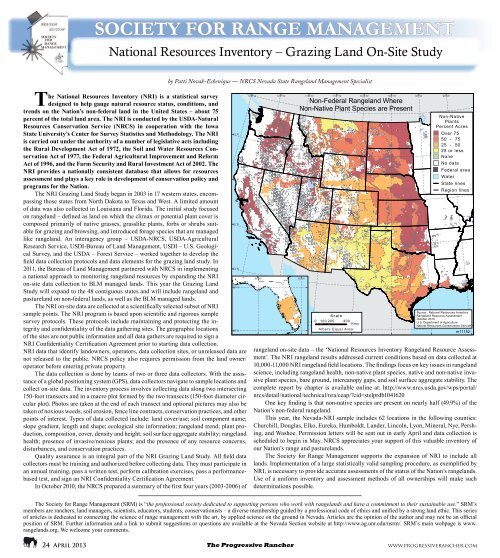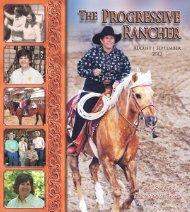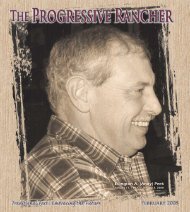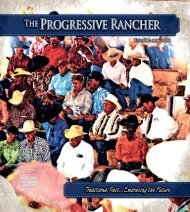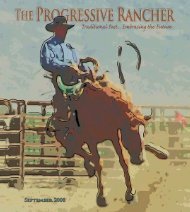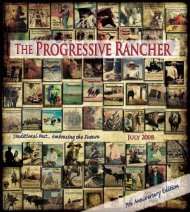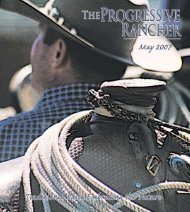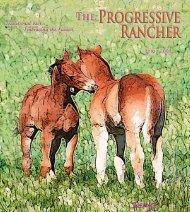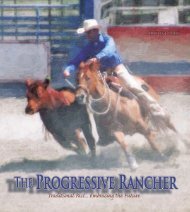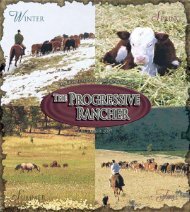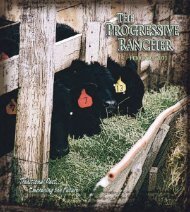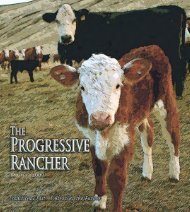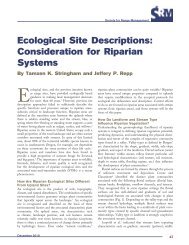NCA 2009 President's Award Recipient - The Progressive Rancher ...
NCA 2009 President's Award Recipient - The Progressive Rancher ...
NCA 2009 President's Award Recipient - The Progressive Rancher ...
Create successful ePaper yourself
Turn your PDF publications into a flip-book with our unique Google optimized e-Paper software.
SOCIETY FOR RANGE MANAGEMENT<br />
National Resources Inventory – Grazing Land On-Site Study<br />
<strong>The</strong> National Resources Inventory (NRI) is a statistical survey<br />
designed to help gauge natural resource status, conditions, and<br />
trends on the Nation’s non-federal land in the United States – about 75<br />
percent of the total land area. <strong>The</strong> NRI is conducted by the USDA-Natural<br />
Resources Conservation Service (NRCS) in cooperation with the Iowa<br />
State University’s Center for Survey Statistics and Methodology. <strong>The</strong> NRI 45°N<br />
is carried out under the authority of a number of legislative acts including<br />
the Rural Development Act of 1972, the Soil and Water Resources Conservation<br />
Act of 1977, the Federal Agricultural Improvement and Reform<br />
Act of 1996, and the Farm Security and Rural Investment Act of 2002. <strong>The</strong><br />
NRI provides a nationally consistent database that allows for resources<br />
assessment and plays a key role in development of conservation policy and 40°N<br />
programs for the Nation.<br />
<strong>The</strong> NRI Grazing Land Study began in 2003 in 17 western states, encompassing<br />
those states from North Dakota to Texas and West. A limited amount<br />
of data was also collected in Louisiana and Florida. <strong>The</strong> initial study focused<br />
on rangeland – defined as land on which the climax or potential plant cover is<br />
composed primarily of native grasses, grasslike plants, forbs or shrubs suitable<br />
for grazing and browsing, and introduced forage species that are managed<br />
35°N<br />
like rangeland. An interagency group – USDA-NRCS, USDA-Agricultural<br />
Research Service, USDI-Bureau of Land Management, USDI – U.S. Geological<br />
Survey, and the USDA – Forest Service – worked together to develop the<br />
field data collection protocols and data elements for the grazing land study. In<br />
2011, the Bureau of Land Management partnered with NRCS in implementing 30°N<br />
a national approach to monitoring rangeland resources by expanding the NRI<br />
on-site data collection to BLM managed lands. This year the Grazing Land<br />
30°N<br />
Study will expand to the 48 contiguous states and will include rangeland and<br />
pastureland on non-federal lands, as well as the BLM managed lands.<br />
<strong>The</strong> NRI on-site data are collected at a scientifically selected subset of NRI<br />
25°N<br />
sample points. <strong>The</strong> NRI program is based upon scientific and rigorous sample<br />
survey protocols. <strong>The</strong>se protocols include maintaining and protecting the integrity<br />
and confidentiality of the data gathering sites. <strong>The</strong> geographic locations<br />
25°N<br />
of the sites are not public information and all data gathers are required to sign a<br />
NRI Confidentiality Certification Agreement prior to starting data collection.<br />
NRI data that identify landowners, operators, data collection sites, or unreleased data are<br />
not released to the public. NRCS policy also requires permission from the land owner/<br />
operator before entering private property.<br />
<strong>The</strong> data collection is done by teams of two or three data collectors. With the assistance<br />
of a global positioning system (GPS), data collectors navigate to sample locations and<br />
collect on-site data. <strong>The</strong> inventory process involves collecting data along two intersecting<br />
150-foot transects and in a macro plot formed by the two transects (150-foot diameter circular<br />
plot). Photos are taken at the end of each transect and optional pictures may also be<br />
taken of noxious weeds, soil erosion, fence line contracts, conservation practices, and other<br />
points of interest. Types of data collected include: land cover/use; soil component name;<br />
slope gradient, length and shape; ecological site information; rangeland trend; plant production,<br />
composition, cover, density and height; soil surface aggregate stability; rangeland<br />
health; presence of invasive/noxious plants; and the presence of any resource concerns,<br />
disturbances, and conservation practices.<br />
Quality assurance is an integral part of the NRI Grazing Land Study. All field data<br />
collectors must be training and authorized before collecting data. <strong>The</strong>y must participate in<br />
an annual training, pass a written test, perform calibration exercises, pass a performancebased<br />
test, and sign an NRI Confidentiality Certification Agreement.<br />
In October 2010, the NRCS prepared a summary of the first four years (2003-2006) of<br />
by Patti Novak-Echenique — NRCS Nevada State Rangeland Management Specialist<br />
125°W<br />
85°W<br />
120°W<br />
80°W<br />
115°W<br />
110°W<br />
105°W<br />
rangeland on-site data – the ‘National Resources Inventory Rangeland Resource Assessment’.<br />
<strong>The</strong> NRI rangeland results addressed current conditions based on data collected at<br />
10,000-11,000 NRI rangeland field locations. <strong>The</strong> findings focus on key issues in rangeland<br />
science, including rangeland health, non-native plant species, native and non-native invasive<br />
plant species, bare ground, intercanopy gaps, and soil surface aggregate stability. <strong>The</strong><br />
complete report by chapter is available online at: http://www.nrcs.usda.gov/wps/portal/<br />
nrcs/detail/national/technical/nra/ceap/?cid=stelprdb1041620<br />
One key finding is that non-native species are present on nearly half (49.9%) of the<br />
Nation’s non-federal rangeland.<br />
This year, the Nevada-NRI sample includes 62 locations in the following counties:<br />
Churchill, Douglas, Elko, Eureka, Humboldt, Lander, Lincoln, Lyon, Mineral, Nye, Pershing,<br />
and Washoe. Permission letters will be sent out in early April and data collection is<br />
scheduled to begin in May. NRCS appreciates your support of this valuable inventory of<br />
our Nation’s range and pasturelands.<br />
<strong>The</strong> Society for Range Management supports the expansion of NRI to include all<br />
lands. Implementation of a large statistically valid sampling procedure, as exemplified by<br />
NRI, is necessary to provide accurate assessments of the status of the Nation’s rangelands.<br />
Use of a uniform inventory and assessment methods of all ownerships will make such<br />
determinations possible.<br />
100°W<br />
Non-Federal Rangeland Where<br />
Non-Native Plant Species are Present<br />
Sc a l e<br />
0 1 0 0 2 0 0 4 0 0<br />
K m s<br />
A lber s E q u a l A re a<br />
95°W<br />
90°W<br />
Non-Native<br />
Plants<br />
Percent Acres<br />
Over 75<br />
50 - 75<br />
25 - 50<br />
25 or less<br />
None<br />
No data<br />
Federal area<br />
Water<br />
State lines<br />
Region lines<br />
Source: National Resources Inventory<br />
Rangeland Resource Assessment<br />
October 2010<br />
U.S. Department of Agriculture<br />
Natural Resources Conservation Service<br />
m11152<br />
<strong>The</strong> Society for Range Management (SRM) is “the professional society dedicated to supporting persons who work with rangelands and have a commitment to their sustainable use.” SRM’s<br />
members are ranchers, land managers, scientists, educators, students, conservationists – a diverse membership guided by a professional code of ethics and unified by a strong land ethic. This series<br />
of articles is dedicated to connecting the science of range management with the art, by applied science on the ground in Nevada. Articles are the opinion of the author and may not be an official<br />
position of SRM. Further information and a link to submit suggestions or questions are available at the Nevada Section website at http://www.ag.unr.edu/nsrm/. SRM’s main webpage is www.<br />
rangelands.org. We welcome your comments.<br />
24 April 2013<br />
<strong>The</strong> <strong>Progressive</strong> <strong>Rancher</strong><br />
www.progressiverancher.com


